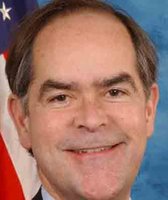Stand up for the facts!
Our only agenda is to publish the truth so you can be an informed participant in democracy.
We need your help.
I would like to contribute

Blades of death for birds? Yes, but some claim the numbers Alexander cites are overstated.
U.S. Sen. Lamar Alexander has spoken out for years against federal subsidies for wind energy, which he argues is expensive and unreliable.
In a speech on the Senate floor on Feb. 15, the Tennessee Republican touched on many of his usual themes: Nuclear power is a better source for clean, reliable energy. Wind energy produces a puny amount of electricity. The giant windmills needed to generate electricity can be seen for miles and interfere with natural scenic vistas.
He also hit on another provocative argument against a four-year extension of tax credits for wind energy.
"On top of all that," Alexander said, "these giant turbines have become a Cuisinart in the sky for birds. … And wind turbines kill over 400,000 birds every year."
The thought of windmills with football-field-size blades chopping up birds like a kitchen appliance is indeed a disturbing bit of imagery, and 400,000-plus dead birds a year seems like an awfully high body count.
So we thought we would look into it.
Turns out, getting a handle on bird deaths is not an easy task. Most experts agree that a lot of birds die every year when they come into contact with windmills. But estimates on exactly how many are killed vary widely. Because there is no clear consensus, we decided not to put Alexander’s statement to the Truth-O-Meter test. But since the numbers the senator cited have been quoted widely by other groups and publications, we thought it important to provide some context.
Alexander’s press spokesman, Jim Jeffries, told us the "over 400,000" figure the senator cited came from the American Bird Conservancy, a nonprofit group whose mission is to protect native birds and their habitats, and from a report by the U.S. Fish and Wildlife Service.
Robert Johns, a spokesman for the American Bird Conservancy, told us the group got its estimate from the same Fish and Wildlife report Alexander’s office had cited.
The report in question was written in 2009 by Albert Manville, a respected biologist in Fish and Wildlife’s Division of Migratory Bird Management. Manville’s estimates of the bird fatalities caused by wind turbines have been cited in testimony before a congressional committee and in newspapers such as The New York Times and the Los Angeles Times.
In an interview with PolitiFact Tennessee, Manville said he took the wind industry’s bird fatality estimate at the time – roughly 58,000 birds per year – and tried to correct or update it by taking into account what he thought were a number of "biases" that had not been considered in other studies. Among them: inconsistencies in duration and intensity of searches for bird kills, the size of search areas, a failure to estimate bird mortality during peak periods of migration, the impact from wake turbulence and inclement weather events.
Based on his research, Manville estimated that more than 440,000 birds are killed every year in the United States by wind turbines. But, he cautioned, "it’s an estimate, and that’s really all you can say about it, frankly."
"It’s a ballpark figure, and I would say Sen. Alexander’s characterization (of the report) is accurate," Manville said. Still, "the point of the discussion is not getting stuck in the weeds on actual numbers here, but rather how do we develop wind energy in environmentally responsible ways. That is kind of the bottom line for the Fish and Wildlife Service."
Not surprisingly, a group that promotes wind energy disputes Manville’s numbers.
John Anderson of the American Wind Energy Association points out that the American Bird Conservancy has used a much lower estimate in the past. Indeed, the conservancy estimated in 2003 that between 10,000 and 40,000 birds were killed each year at wind farms across the country, about 80 percent of which were songbirds and 10 percent birds of prey.
However, Johns, the bird conservancy spokesman, told PolitiFact in 2010 that turbine capacity has increased in recent years and that, at that time, the group had changed its estimate to reflect that 100,000 to 300,000 birds are killed by turbines each year.
Anderson, the wind energy association’s director of siting policy, also pointed to a 2007 study from the National Research Council, which concluded that bird deaths caused by wind turbines are a minute fraction of the total anthropogenic bird deaths -- less than 0.003 percent in 2003.
In fact, the study said, far more birds die every year in other ways:
--Collisions with buildings may kill up to 976 million birds annually;
--Collisions with high-tension lines kill at least 130 million birds, perhaps more than 1 billion;
--Cars may kill 80 million birds per year.
Another notorious bird killer: Domestic and feral cats, which may kill hundreds of millions of songbirds and other avian species each year, Fish and Wildlife Service reported in 2002. In Wisconsin alone, the agency said, roughly 39 million birds are killed by domestic cats every year. Add in the deaths caused by feral cats, or domestic cats in rural and suburban areas, and the mortality figure would be much higher.
In its study, the National Research Council estimated that wind turbines killed 20,000 to 37,000 birds in 2003, with all but 9,200 of those deaths occurring in California. What’s more, Anderson said, the 400,000-plus figure cited by Alexander is not an official estimate from the Fish and Wildlife Service.
David Cottingham, senior adviser to Fish and Wildlife Director Dan Ashe, confirmed that the 440,000 bird deaths often attributed to the division are actually the estimates of one biologist – Manville – and are not considered official agency statistics.
"I’m not going to criticize Al’s numbers," Cottingham said. "But I’m also going to tell you, in the service, we recognize those as Al’s. … They are not what I would call official Fish and Wildlife estimates."
Several attempts have been made to get an accurate accounting of birds killed by windmills, Cottingham said, but "nobody knows the real answer."
"To say that U.S. Fish and Wildlife Service says it’s 440,000 would be very much an overstatement at this point," Cottingham said.
The National Wind Coordinating Collaborative, which includes Fish and Wildlife officials and representatives from the wind industry, utilities and others, looked at the issue and concluded there are roughly three to four birds killed per megawatt every year. With current capacity at roughly 50,000 megawatts, that comes to 150,000 to 200,000 birds per year.
Cottingham said those estimates are the ones Fish and Wildlife would be most likely to cite when asked about bird deaths caused by turbines. But, he stressed, "That’s a national average. It’s real hard to come up with one number. People have done 40 to 50 studies, and the ranges are all over the place."
Bottom line: Because bird mortality estimates vary widely, we can’t make a Truth-O-Meter ruling on Sen. Alexander’s statement. Until a more definite study is done, the only thing we can say is that a lot of birds are killed every year by wind turbines -- though other things like cars, cats and high-tension power lines cause many thousands of times more bird deaths than wind turbines.
Our Sources
Sen. Lamar Alexander, speech on Senate floor, Feb. 15, 2012.
Jim Jeffries, spokesman for Sen. Alexander, in an email to PolitiFact, Feb. 29, 2012.
Robert Johns, American Bird Conservancy, interview with PolitiFact, Feb. 28, 2012.
Albert Manville, Towers, Turbines, Power Lines and Buildings -- Steps Being Taken By The U.S. Fish And Wildlife Service To Avoid Or Minimize Take Of Migratory Birds At These Structures, 2009.
Elizabeth Rosenthal, Tweety Was Right: Cats Are a Bird’s No. 1 Enemy, The New York Times, March 20, 2011.
Louis Sahagun, Bird advocates urge mandatory standards for wind energy projects, Los Angeles Times, Dec. 14, 2011.
Albert Manville, PolitiFact interview, Feb. 28, 2012.
John Anderson, American Wind Energy Association, PolitiFact interview, Feb. 29, 2012.
National Academies Press, Committee on Environmental Impacts of Wind Energy Projects, National Research Council, 2007.
U.S. Fish and Wildlife Service, Migratory Bird Mortality, January 2002.
David Cottingham, U.S. Fish and Wildlife Service, PolitiFact interview, Feb. 29, 2012.
PolitiFact check, "Checking George Will on birds and wind turbines,"
May 3rd, 2010.























































